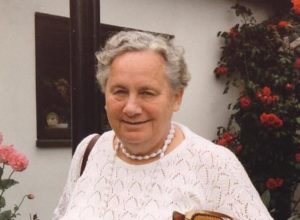
There was a large crowd gathered at Koinonia Church in Patan to celebrate Eileen’s long life, and to say “goodbye” to this lady who has touched countless lives in so many ways. Eileen’s funeral was attended by about 500 people who travelled from near and far to mark the occasion with their personal honouring of and thanks for, a lady who in many cases changed their own lives in substantial ways. Many shared their experiences of Eileen and her love with those gathered, and the event was an unhurried tribute to the amazing ways in which Eileen blessed all those that came to her for help.
The funeral service on 16th October at Patan Koinonia Church can be viewed on youtube from the following two links:
https://www.youtube.com/watch?v=5HWQMXPSGy8
https://www.youtube.com/watch?v=1IBgSE9PQdI
Eileen was buried on Thursday 17th October in her favourite place – Green Pastures Hospital in Pokhara – with Psalm 23 as the theme for the service, as it was the theme in her life.

Eileen travelled to Nepal in 1953, joining two medical missionaries, Dr Lily O’Hanlon and Hilda Steele, who founded Shining Hospital in Pokhara. Eileen went on to found Green Pastures Leprosy Hospital in Pokhara in 1957, moved by the terrible conditions suffered by those affected with leprosy, and became its Superintendent until the later 1960s. Eileen then moved to Kathmandu to carry leprosy work east, and assisted TLM Anandaban hospital for some time, while also working with the leprosy colony at Kokhana on the edge of the Kathmandu Valley. During the following few years she rescued a number of children from Kokhana, putting them into various educations and vocational trainings, to prepare them for her vision for the establishment of a leprosy referral hospital in the south east of Nepal where she felt it was desperately needed. Eileen also established several income generating workshops for leprosy-affected people, producing candles, pottery, and leather work. Alongside those she also founded a well-regarded technical school that produced students in various skills areas, including metalwork, carpentry, and secretarial skills. Out of these initiatives, the leather workshop has continued for nearly 50 years and still produces quality leather, cloth and felt goods that are sold around the world.
It was also during this time that Eileen set up Nepal Leprosy Trust as a charity in the UK in March of 1972, providing a formal platform for fundraising, awareness and praying for the work in Nepal. Through these years, Eileen remained committed to obtaining permission to build a leprosy referral centre in south east Nepal, and went on several major fact-finding expeditions to the area around Janakpur, to see what was there. She looked at the then almost non-existent leprosy services, and surveyed for patients. She found many people affected by leprosy who had no access to services, and yet the powers that were in place at the time in Nepal firmly resisted any further mission hospital building and for ten years blocked Eileen’s requests for permission to establish her hospital despite the clear need for it. Eileen used this time well, training groups of people from Kokhana in farming and agriculture, and resettling them onto land given by the government for this purpose. This resulted in two new villages being established in the south of Nepal, and new lives for many people affected by leprosy.
The momentous changes that took place in Nepal in 1989 leading to democracy, also broke the stalemate on the permission to build that Eileen was seeking, and she was finally allowed to proceed. Government land near Lalgadh Village in Dhanusha District was granted, and Lalgadh Leprosy Hospital and Services Centre came into being over the next 6 years. This was in itself a miracle because the financial turnover of NLT was only about £10k per year at that time and the new centre would cost about £650k. Somehow all the money came, and none of it was from governments or major donors – it all came from ordinary people moved to support the work that Eileen was doing. Lalgadh has grown through many challenges over the following 20 years to become a highly regarded and very busy centre for leprosy and dermatology, as well as an innovator in community work to reduce the stigma of leprosy.
Eileen’s drive to take leprosy services further and further east led her to move on from NLT in the later 1990s to found Nepal Leprosy Fellowship which has developed services in the district of Jappa, Morang and Sunsari. Her contribution to leprosy work in Nepal is very considerable and ranges from the west to the far east of Nepal. Eileen has been responsible for establishing leprosy works in Pokhara, Kathmandu, Lalgadh, and Dharan. To do that more effectively she gave up her British citizenship and became a Nepali citizen, and lived there for 66 years, passing away in Kumari Pati in Kathmandu where she had lived for many years. Her desire to give and give, and to believe for big things has challenged all who knew her to be more filled with faith and to trust God in the face of the impossible.
Eileen has gone home to be with her Lord Jesus, and we remember her with a mixture of fondness and awe. She will be greatly missed.